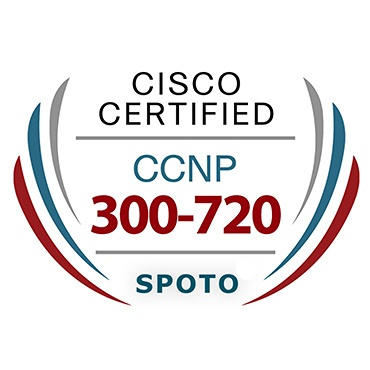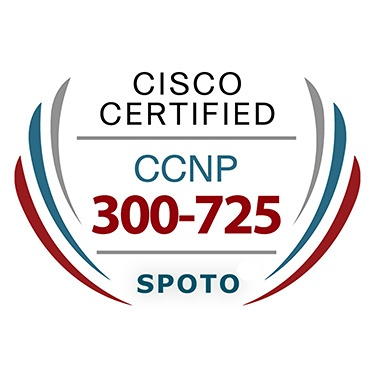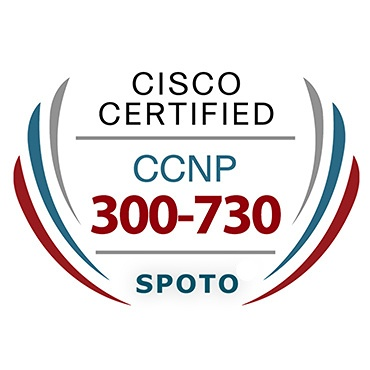Security Concentration
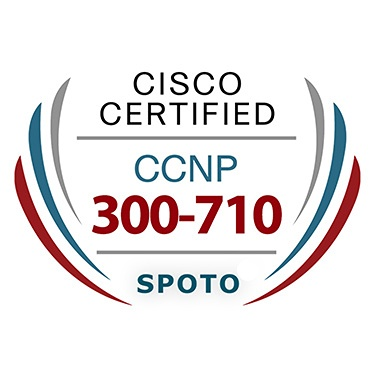
Top CCNP 300-710 SNCF Exam Questions for Guaranteed Success in 2023
The CCNP Security (300-710 SPNC) exam measures your knowledge of policies, deployments, management, and troubleshooting about Cisco Firepower(r), Threat Defense and Firepower(r), 7000 and Firepower(r), 8000 Series virtual appliances. The main purpose of the exam is to teach you about Next-Generation Firewalls and Next-Generation Intrusion Prevention System capabilities like file type identification, network-based Malware detection, and deep packet inspection. Candidates with the following profiles are eligible to take this exam: Security professionals Security consultants Administrators of the network System engineers Support personnel for technical issues Resellers and channel partners Cisco partners and integrators Exam Prerequisites No formal prerequisites are required. There are a few areas where knowledge is an advantage: TCP/IP networking technical understanding and network architecture Basic knowledge of Intrusion Detection Systems, (IDS), and IPS. Basic routing protocols and TCP/IP knowledge Familiarity and familiarity with Intrusion Prevention Systems (IPS), VPN, and firewall concepts Exam Details It costs $300 and is coded 300-710 SNCF. The exam takes 90 minutes. Multiple-choice questions are available. The certification is valid for 3 years. Both English and Japanese are accepted for the test. Cisco CCNP Security (300-710 SNCF Exam) covers the following topics: 1. Deployment: 30% 1.1 Implement NGFW mode ( Cisco Documentation Transparent, Routed Firewall Mode). Routed mode Transparent mode 1.2 Implement NGIPS modes (Cisco Documentation: Next-Generation Intrusion Prevention System (NGIPS)) Passive Inline 1.3 Implement high availability options. Cisco Documentation Configuring High Availability Link redundancy Standby/active failover Multi-instance 1.4 Describe IRB configurations ( Cisco Documentation Configuring IRB 2. Configuration: 30% 2.1 Configure system configurations in Cisco Firepower Management Center ( Cisco Documentation Firepower Management Center Configuration Manual). 2.2 Configure the following policies in Cisco Firepower Management Center ( Cisco Documentation Getting Started with Firepower). Control of access Intrusion Malware and file DNS Identity SSL Prefilter 2.3 Configure the following features with Cisco Firepower Management Center ( Cisco documentation: Cisco Firepower Management Center). Network discovery Application detectors (Open AppID) Correlation Take Action 2.4 Configure objects with Firepower Management Center ( Cisco Documentation Navigating Cisco Firepower Documentation Object Management Intrusion Rules 2.5 Configure devices using Firepower Management Center (Cisco Documentation: Firepower) Device Management NAT VPN QoS Setting up a platform Certificates 3. Troubleshooting and Management: 25% Troubleshooting FMC CLI/GUI ( Cisco Documentation Cisco UCS Manager GUI Configuration guide FMC Documentation: Working With Reports - Configure Dashboards and Reporting Troubleshooting using packet capture procedures ( Cisco documentation: Packet Capture Procedures on Cisco Firepower device). Analyze risk and standard reporting ( Cisco Documentation Reports). 4. Integration: 15% Configure Cisco AMP for Networks in Firepower Management Center ( Cisco Documentation Cisco AMP for Networks). Firepower Management Center Configure Cisco AMP For Endpoints ( Cisco Documentation AMP For Endpoints User Guide Third-party security intelligence feeds can be implemented by the Implement Threat Intelligence Director ( Cisco Documentation Cisco Threat Director (TID). Describe Cisco Threat Response to security investigations ( Cisco Documentation Cisco Threat Respond). Cisco FMC PxGrid Integration With Cisco Identify Services Engine (ISE). ( Cisco Documentation Configure ISE 2.4 & FMC 6.2.3 pxGrid Integr Rapid Threat Containment (RTC), functionality in Firepower Management Center ( Cisco Documentation Cisco Rapid Threat Containment). Practice Exams You should practice what you have learned to be able to analyze your practice. By practicing, you can improve your answering skills which will save you a lot of time. Also, practice tests can be started after you have completed a topic. This will serve as a revision section

Top CCNP 300-710 SNCF Exam Questions for Guaranteed Success in 2023
The CCNP Security (300-710 SPNC) exam measures your knowledge of policies, deployments, management, and troubleshooting about Cisco Firepower(r), Threat Defense and Firepower(r), 7000 and Firepower(r), 8000 Series virtual appliances. The main purpose of the exam is to teach you about Next-Generation Firewalls and Next-Generation Intrusion Prevention System capabilities like file type identification, network-based Malware detection, and deep packet inspection. Candidates with the following profiles are eligible to take this exam: Security professionals Security consultants Administrators of the network System engineers Support personnel for technical issues Resellers and channel partners Cisco partners and integrators Exam Prerequisites No formal prerequisites are required. There are a few areas where knowledge is an advantage: TCP/IP networking technical understanding and network architecture Basic knowledge of Intrusion Detection Systems, (IDS), and IPS. Basic routing protocols and TCP/IP knowledge Familiarity and familiarity with Intrusion Prevention Systems (IPS), VPN, and firewall concepts Exam Details It costs $300 and is coded 300-710 SNCF. The exam takes 90 minutes. Multiple-choice questions are available. The certification is valid for 3 years. Both English and Japanese are accepted for the test. Cisco CCNP Security (300-710 SNCF Exam) covers the following topics: 1. Deployment: 30% 1.1 Implement NGFW mode ( Cisco Documentation Transparent, Routed Firewall Mode). Routed mode Transparent mode 1.2 Implement NGIPS modes (Cisco Documentation: Next-Generation Intrusion Prevention System (NGIPS)) Passive Inline 1.3 Implement high availability options. Cisco Documentation Configuring High Availability Link redundancy Standby/active failover Multi-instance 1.4 Describe IRB configurations ( Cisco Documentation Configuring IRB 2. Configuration: 30% 2.1 Configure system configurations in Cisco Firepower Management Center ( Cisco Documentation Firepower Management Center Configuration Manual). 2.2 Configure the following policies in Cisco Firepower Management Center ( Cisco Documentation Getting Started with Firepower). Control of access Intrusion Malware and file DNS Identity SSL Prefilter 2.3 Configure the following features with Cisco Firepower Management Center ( Cisco documentation: Cisco Firepower Management Center). Network discovery Application detectors (Open AppID) Correlation Take Action 2.4 Configure objects with Firepower Management Center ( Cisco Documentation Navigating Cisco Firepower Documentation Object Management Intrusion Rules 2.5 Configure devices using Firepower Management Center (Cisco Documentation: Firepower) Device Management NAT VPN QoS Setting up a platform Certificates 3. Troubleshooting and Management: 25% Troubleshooting FMC CLI/GUI ( Cisco Documentation Cisco UCS Manager GUI Configuration guide FMC Documentation: Working With Reports - Configure Dashboards and Reporting Troubleshooting using packet capture procedures ( Cisco documentation: Packet Capture Procedures on Cisco Firepower device). Analyze risk and standard reporting ( Cisco Documentation Reports). 4. Integration: 15% Configure Cisco AMP for Networks in Firepower Management Center ( Cisco Documentation Cisco AMP for Networks). Firepower Management Center Configure Cisco AMP For Endpoints ( Cisco Documentation AMP For Endpoints User Guide Third-party security intelligence feeds can be implemented by the Implement Threat Intelligence Director ( Cisco Documentation Cisco Threat Director (TID). Describe Cisco Threat Response to security investigations ( Cisco Documentation Cisco Threat Respond). Cisco FMC PxGrid Integration With Cisco Identify Services Engine (ISE). ( Cisco Documentation Configure ISE 2.4 & FMC 6.2.3 pxGrid Integr Rapid Threat Containment (RTC), functionality in Firepower Management Center ( Cisco Documentation Cisco Rapid Threat Containment). Practice Exams You should practice what you have learned to be able to analyze your practice. By practicing, you can improve your answering skills which will save you a lot of time. Also, practice tests can be started after you have completed a topic. This will serve as a revision section
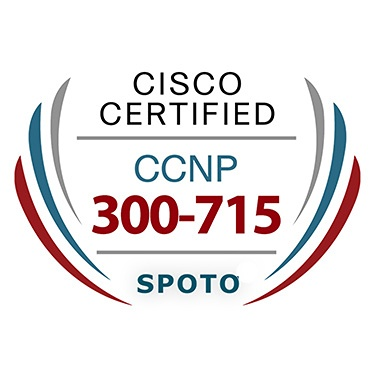
Top CCNP 300-715 SISE Exam Questions for Guaranteed Success in 2023
The SISE 300-715 Configuring and Implementing Cisco Identity Services Engine exam is a 90-minute exam that covers the CCNP Security certifications and Cisco Certified Specialist Security Identity Management Implementation certifications. The Cisco Identity Services Engine 300-715 exam is designed to test a candidate's knowledge. These areas include policy enforcement, architecture and deployment, Web Auth, guest services, profiler, and BYOD as well as network access device management. Who are the Target Audiences for the 300-715 Exam Exam? Network security engineers Administrators of ISE Engineers for wireless network security Cisco partners and integrators A candidate who passes the 300-715 Certificate exam should be able: Define Cisco ISE deployments. They will be able to describe how they interact to create an integrated security architecture. Discuss the benefits of such deployments and how each Cisco IISE capability contributes. Describe concepts and configure components for 802.1X and MAC Authentication Bypass, (MAB), authentication, identity management, and certificate services. Candidates would be asked to explain how Cisco ISE policy sets are used to enable authorization and authentication, and how they can help their company meet its needs. Define third-party Network Access Devices, (NADs), Cisco TrustSec, or Easy Connect. Configure and describe web authentication processes, operations, and guest services. This includes guest access components and different guest access scenarios. Summary of the 300-715 Examination: Candidates must work hard to answer the 55 to 65 questions. SISE exam. Although the exam is multiple-choice, candidates may encounter scenario-based questions. How to prepare for the 300-715 Exam? The Implementing Cisco Identity Services Engine v3.0 training teaches a candidate how to deploy and use the Cisco Identity Services Engine v2.4. This engine is an access control and identity platform that facilitates consistent and secure access control over wired and wireless connections. This hands-on course provides candidates with the knowledge and skills to use Cisco ISE. It includes profiling services and policy enforcement. Web authentication, guest access, BYOD, and device administration. A candidate will learn how to use Cisco ISE through expert instruction and practical practice. This will allow them to gain visibility into the network and streamline security policy management. It will also help improve operational efficiency. Don't Forget to Practice The most important part of the Cisco exam preparation is practicing. After a candidate has mastered all topics, he can begin taking online 300-715 practice tests. Exam preparation level checks are only possible if you're able to evaluate yourself. Continuous online practice helps candidates to identify their strengths and weaknesses. Practice tests increase confidence and prepare you to take the real exam. What are the benefits of the CCNP300-715 Certification? Increase Your Resume Value With the 300-715 Certificate: Network security is a major concern. The demand for certified candidates is growing as threats increase. Employers will be more likely to trust your abilities and talents in network security once you have a CCNP Security certificate like the 300-715. A CCNP Security certification requires extensive fieldwork. Having the certification on your resume proves your knowledge and skills. Excellent Job Growth: A CNP Security certificate will make your career easier. The certification will make you more qualified than non-certified candidates whether you're looking for a promotion or a job switch. Certified candidates are more likely to negotiate a better salary. CCNP Security certification 300-715 makes you qualified for high-growth positions in the future. Many Cisco certifications are required steps to obtain more advanced certifications. They also provide the additional training that is necessary for higher-level designations and certifications. With the CCNP security certificate, it is clear that this is the truth. Get the Cisco 300-715 certification to help you get ahead in your career.

Top CCNP 300-715 SISE Exam Questions for Guaranteed Success in 2023
The SISE 300-715 Configuring and Implementing Cisco Identity Services Engine exam is a 90-minute exam that covers the CCNP Security certifications and Cisco Certified Specialist Security Identity Management Implementation certifications. The Cisco Identity Services Engine 300-715 exam is designed to test a candidate's knowledge. These areas include policy enforcement, architecture and deployment, Web Auth, guest services, profiler, and BYOD as well as network access device management. Who are the Target Audiences for the 300-715 Exam Exam? Network security engineers Administrators of ISE Engineers for wireless network security Cisco partners and integrators A candidate who passes the 300-715 Certificate exam should be able: Define Cisco ISE deployments. They will be able to describe how they interact to create an integrated security architecture. Discuss the benefits of such deployments and how each Cisco IISE capability contributes. Describe concepts and configure components for 802.1X and MAC Authentication Bypass, (MAB), authentication, identity management, and certificate services. Candidates would be asked to explain how Cisco ISE policy sets are used to enable authorization and authentication, and how they can help their company meet its needs. Define third-party Network Access Devices, (NADs), Cisco TrustSec, or Easy Connect. Configure and describe web authentication processes, operations, and guest services. This includes guest access components and different guest access scenarios. Summary of the 300-715 Examination: Candidates must work hard to answer the 55 to 65 questions. SISE exam. Although the exam is multiple-choice, candidates may encounter scenario-based questions. How to prepare for the 300-715 Exam? The Implementing Cisco Identity Services Engine v3.0 training teaches a candidate how to deploy and use the Cisco Identity Services Engine v2.4. This engine is an access control and identity platform that facilitates consistent and secure access control over wired and wireless connections. This hands-on course provides candidates with the knowledge and skills to use Cisco ISE. It includes profiling services and policy enforcement. Web authentication, guest access, BYOD, and device administration. A candidate will learn how to use Cisco ISE through expert instruction and practical practice. This will allow them to gain visibility into the network and streamline security policy management. It will also help improve operational efficiency. Don't Forget to Practice The most important part of the Cisco exam preparation is practicing. After a candidate has mastered all topics, he can begin taking online 300-715 practice tests. Exam preparation level checks are only possible if you're able to evaluate yourself. Continuous online practice helps candidates to identify their strengths and weaknesses. Practice tests increase confidence and prepare you to take the real exam. What are the benefits of the CCNP300-715 Certification? Increase Your Resume Value With the 300-715 Certificate: Network security is a major concern. The demand for certified candidates is growing as threats increase. Employers will be more likely to trust your abilities and talents in network security once you have a CCNP Security certificate like the 300-715. A CCNP Security certification requires extensive fieldwork. Having the certification on your resume proves your knowledge and skills. Excellent Job Growth: A CNP Security certificate will make your career easier. The certification will make you more qualified than non-certified candidates whether you're looking for a promotion or a job switch. Certified candidates are more likely to negotiate a better salary. CCNP Security certification 300-715 makes you qualified for high-growth positions in the future. Many Cisco certifications are required steps to obtain more advanced certifications. They also provide the additional training that is necessary for higher-level designations and certifications. With the CCNP security certificate, it is clear that this is the truth. Get the Cisco 300-715 certification to help you get ahead in your career.
